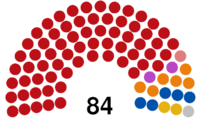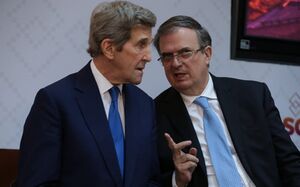Vanhar: Difference between revisions
(→Music) |
|||
| Line 164: | Line 164: | ||
After the Great War ended, Edmundo Esteves turned his rebellion against the AFR. He would continue to hide out his forces in the desert and forests of Vanhar for the next year until he was captured by government troops in 1936. He would be tried for treason and executed by the AFR's government. Vanhar's next governor was [[Duarte Jarl]], he was an ally of [[Carlos Padin]] and member of the [[National Progressive Party]], he would rule from 1937 to 1944 when he tied of cancer. He was succeeded by [[Vicente Rebelo Mata]], who would be Governor of Vanhar and push for liberal reforms for 17 years, he was extremely popular and considered essential for the creation of the AFR's Golden Decade. He would create a liberal ideology known as [[Rebelismo]], which focused on civic nationalism and liberal ideals. | After the Great War ended, Edmundo Esteves turned his rebellion against the AFR. He would continue to hide out his forces in the desert and forests of Vanhar for the next year until he was captured by government troops in 1936. He would be tried for treason and executed by the AFR's government. Vanhar's next governor was [[Duarte Jarl]], he was an ally of [[Carlos Padin]] and member of the [[National Progressive Party]], he would rule from 1937 to 1944 when he tied of cancer. He was succeeded by [[Vicente Rebelo Mata]], who would be Governor of Vanhar and push for liberal reforms for 17 years, he was extremely popular and considered essential for the creation of the AFR's Golden Decade. He would create a liberal ideology known as [[Rebelismo]], which focused on civic nationalism and liberal ideals. | ||
[[File:ERP combatants Perquín 1990 24.jpg|250px|thumb|left|Separatists in the AFR, known as the [[Separadors]], sprung up in the 1980s]] | [[File:ERP combatants Perquín 1990 24.jpg|250px|thumb|left|Separatists in the AFR, known as the [[Separadors]], sprung up in the 1980s]] | ||
During the AFR's war with Chistovodia lead to more military influence in the government, including that of Vanhar. Rebelo Mata was ousted in 1961 by the military takeover of the AFR. He would be replaced by General [[Gustavo Anderberg]], who would crush dissent and opposition in Vanhar and was an ally of Luis Parola and Marcos Leao. In 1981 he was replaced by [[Asimo Luzilho]], who would continue military policy in Vanhar, but his term saw the rise of separatists in southern Vanhar and economic instability. The [[Separadors]] as they were called would be mostly left-wing and were heavily backed by Chistovodia. These separatists allied with others from other states across the southeast AFR. | During the AFR's war with Chistovodia lead to more military influence in the government, including that of Vanhar. Rebelo Mata was ousted in 1961 by the military takeover of the AFR. He would be replaced by General [[Gustavo Anderberg]], who would crush dissent and opposition in Vanhar and was an ally of Luis Parola and Marcos Leao. Early pro-independent sentiment began to rise again and was supported by Chistovodia during the war. In 1981 he was replaced by [[Asimo Luzilho]], who would continue military policy in Vanhar, but his term saw the rise of separatists in southern Vanhar and economic instability. The [[Separadors]] as they were called would be mostly left-wing and were heavily backed by Chistovodia. These separatists allied with others from other states across the southeast AFR. | ||
===Independence and 1990s=== | ===Independence and 1990s=== | ||
Revision as of 02:19, 3 October 2023
Vanharian Free State | |
|---|---|
| Motto: Ditat Deus "God enriches" | |
| Anthem: Rosa amarela de Vanhar "Yellow Rose of Vanhar" | |
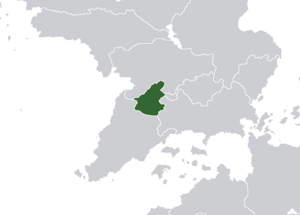 Vanhar in Asteria Superior | |
| Capital and largest city | Aques |
| Official languages | Luzelese Blostlandic Johonai |
| Religion | 86% Sotirianity
2% Native religions 2% Other faiths |
| Demonym(s) | Vanharian |
| Government | Unitary dominant-party presidential republic |
• President | Sérgio Lindahl |
• Deputy President | Eva Quinta Lindahl |
| Legislature | Vanharian Legislative Assembly |
| Establishment | |
• Independence from Eldmark | 1839 |
• Independence from the Asterian Federative Republic | 1989 |
| Area | |
• | 284,623 km2 (109,894 sq mi) |
| Population | |
• 2022 census | 10,874,498 |
| GDP (PPP) | estimate |
• Per capita | 17,301 |
| GDP (nominal) | estimate |
• Per capita | 8,302 |
| Gini | 40.3 medium |
| HDI | 0.669 medium |
| Currency | Vanharian Real |
| Internet TLD | .vr |
Vanhar (Luzelese: Vánhar; Blostlandic: Vänjer), officially the Vanharian Free State (Luzelese: Estado Livre Vánharenha; Blostlandic: Fristaten Vänjerska), is a sovereign country in central Asteria Superior. It is bordered by the Asterian Federative Republic to the north, Eldmark to the south, and Ardesia to the east. It's capitol and largest city is Aques, other major cities include Hannaholm, Saltes, Branco, De Castro, and Blixtoken. It has a population of 10,874,498 people and covers a total area of 284,623 square kilometers. It is made up of 15 Departments, one of them being the National Department of Aques.
The region of Vanhar was initially settled by Zapoyans, Odavli, Kotopa, and Johonai for thousands of years. After the discovery of the Asterias by Assim Asteris. Blostlandic settlers arrived in the area and colonized the area as apart of modern-day Eldmark. The region eventually became settled by agricultural settlers from Euclea, the native population slowly began to be pushed back by colonists, the region became known as Vänjer.
After Eldmark declared independence from Blostland, Luzelese-speaking settlers from the Asterian Federative Republic began to settle south into Vänjer. Eventually the Luzelese population grew to become massive and eventually they declared independence from Eldmark as the Republic of Vanhar. Eventually they voted to join the AFR.
During the late 1800s, the Johonai population and the government of the AFR fought the Johonai War which saw the killings of much of the Johonai nation. Afterwards, the discovery of oil in the north and central parts of Vanhar lead to massive rush of settlers into the area. The oil industry became massive and a major part of the AFR's economy.
After the Great Collapse in 1913, the economy of Vanhar became devastated, the 1916 Cervejaria de Poeira, a massive dust storm that destroyed the agriculture in the region as well. During the Great War, the Ardesian State invaded the AFR, Vanhar became a front for the war, the governor of Vanhar, António Lagerfeld, would collaborate with Ardesian functionalists. A resistance led by the socialist Edmundo Esteves would rise up against both Ardesia and the AFR. He was later executed by the AFR government for his rebellion. After the Great War, governor Vicente Rebelo Mata worked on reforms and rebuilding the state.
In the 1980s the economic downturns and military rule in the AFR lead to separatists, known as the Separadors, to rise up in Vanhar. In 1989 under Bernardo Erhardsson, the government of Vanhar declared independence from the AFR alongside numerous other states. Afterwards the 1990s became full of turmoil as leftist guerillas persisted, and a peace deal in 1999 lead to the rise of the Broad Liberation Front under Geraldo Saldanha. Since 2000 the government has been ruled by the FAL party since, right-wing guerillas still exist in some parts of the country, many wanting to rejoin the AFR. Today Vanhar is lead by President Sérgio Lindahl, and is a part of the CN, LOPS, OAN, and FNPI.
History
Precolonial
Blostlandic colony
Eldmarsk period
Republic period
AFR statehood
Late 1800s
Early 1900s
Great War
Mid 20th century
After the Great War ended, Edmundo Esteves turned his rebellion against the AFR. He would continue to hide out his forces in the desert and forests of Vanhar for the next year until he was captured by government troops in 1936. He would be tried for treason and executed by the AFR's government. Vanhar's next governor was Duarte Jarl, he was an ally of Carlos Padin and member of the National Progressive Party, he would rule from 1937 to 1944 when he tied of cancer. He was succeeded by Vicente Rebelo Mata, who would be Governor of Vanhar and push for liberal reforms for 17 years, he was extremely popular and considered essential for the creation of the AFR's Golden Decade. He would create a liberal ideology known as Rebelismo, which focused on civic nationalism and liberal ideals.
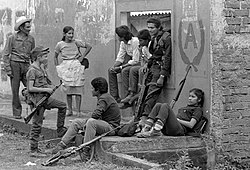
During the AFR's war with Chistovodia lead to more military influence in the government, including that of Vanhar. Rebelo Mata was ousted in 1961 by the military takeover of the AFR. He would be replaced by General Gustavo Anderberg, who would crush dissent and opposition in Vanhar and was an ally of Luis Parola and Marcos Leao. Early pro-independent sentiment began to rise again and was supported by Chistovodia during the war. In 1981 he was replaced by Asimo Luzilho, who would continue military policy in Vanhar, but his term saw the rise of separatists in southern Vanhar and economic instability. The Separadors as they were called would be mostly left-wing and were heavily backed by Chistovodia. These separatists allied with others from other states across the southeast AFR.
Independence and 1990s
In 1989 the government of the AFR was collapsing as much of the military became less interested in the government and began to defect. Separador forces were making gains in the region of Vanhar as well. In 1988 Bernardo Erhardsson was elected as Governor of Vanhar under promise of reforms, but as the situation in the AFR worsened he began to push for independence. Governor Erdhardsson and the State Legislature declared independence in 1989, along with several other states of the eastern AFR. Vanhar became an official member of the Community of Nations soon afterwards. In 1990 a constitution was created and Erhardsson was made the first President of the Free State of Vanhar, he would form the Vanharian Constitutional Party, based on Rebelismo, the ideology of Rebelo Mata. The Direidors became disbanded after independence, but left-wing forces remained and continued to rebel against Erhardsson.
He would ally with the conservative Social Sotirian Unity party, during his rule he founded many governing institutions, he became a major player in the founding of the Forum for International Paretophone Nations, he would attempt to but ultimately failed to join the North Vehemens Organization in 1993. Erhardsson maintained close relations with his AFR counterpart, Jose Ramos, and helped prosecute Vanharians of the previous military state in the National Truth Tribunal. By 1994 the Esquedor situation worsened after they had captured the city of Kunsla in southeast Vanhar. Many claimed that the country was still under authoritarian rule and AFR influence under Erhardsson. These Esquedors included groups like the Estevista Army of National Liberation, or the EELN, which was the largest of the groups. Many of these leftists groups followed the ideology of Esteves, who became a symbol of the Vanharian left. Throughout the 1990s attempts to quell the rebellion were made by Erhardsson, and in 1996 the Vatenfa massacre commited by the military and the assassination of singer Alexandra by an Esquedor supporter would doom his election chances.
In the 1996 election the Social Sotirian Unity party took over under Pedro Riveira, who would push for more severe punishment for Esquedor rebels. He would attempt to join the NVO as well during his term, but this also was not seen through. Riveira worked deeper with the AFR to end the conflict, and in 1999 a peace deal was made under the supervision of Jose Ramos, the disarmament of the Esquedors and introduction of former rebels into a peaceful political system instead would end the conflict. Many Esquedors united into various political parties and were eyeing power in the 2000 election.
21st century Vanhar
After the peace deal many left-wing groups united into political parties. In 2000 the Estevist political party known as the Broad Liberation Front under Geraldo Saldanha would win the election with over 55% of the vote.
Under Geraldo Saldanha many workers' rights reforms were pushed, as well as reforms to the subdivisions, completely getting rid of the indigenous regions, claiming they isolated the indigenous population. Saldanha also integrated the Johonai language into schools and the government. He would pass a law making it mandatory for indigenous representation in regional governments. The FAL would gain a supermajority after uniting with other parties in the 2004 elections, although the opposition and many critics of Saldanha considered the elections to be unfair. In his later terms Saldanha would combat economic downturns and punished banks for failures during the 2005 recession.
Saldanha was succeeded by Sérgio Lindahl, who would lose some seats in the 2008 elections but continued with a supermajority. He would open further relations with the Association for International Socialism, while not being and observer of the organization he would often attend meetings. Lindahl would pass a referendum in 2012 that would deepen FAL control of media in the country. Direidor rebels in the northern regions claiming to want to rejoin the AFR sprung up in 2013, mainly in the region of Coroa de Marta. Lindahl later became adversarial with Tomas Pereira of the AFR and blamed him for the rebels.
Lindahl would make his wife, Eva Quinta Lindahl Deputy President in 2017. Lindahl recently has opened relations up with NVO nations such as Eldmark, but still continues to work with Chistovodia and Choachua politically. Under Lindahl reforms such as a tax law that punished loopholes and reforming Vanhar's economic zones. Talk of succession after Lindahl has arose, with the two favorites for his successor being his wife Eva and Foreign Minister Mauricio Alcantara.
Geography
Flora and fauna
Government and politics
The government of Vanhar is a unitary presidential republic, it is based upon the most recent constitution, the Constitution of the Vanharian Free State, ratified in 1990, which is heavily based on that of the Asterian Federative Republic and Rizealand. The government is divided into three branches, an executive, legislative, and judicial branch.
The executive branch is the office of the President of Vanhar, who serves as both the head of state and head of government, they are also the commander-in-chief of the Vanharian Security Forces, the military forces of Vanhar, they also appoint members of the Cabinet and High Court. The Deputy President of Vanhar is the deputy to the President in all positions of the executive branch and plays a role in the legislative branch.
The next branch is the legislative branch, known as the Vanharian Legislative Assembly, it is lead by the Deputy President of Vanhar, it is a unicameral legislature with a total of 84 seats representing the 15 regions of Vanhar. These seats are divided up into the 15 regions and numbered by population. Since 2009 a region's in the National Legislature are based on party vote country and not direct popular vote.
The third branch of government is the judicial branch, which is lead by the High Court of Vanhar, a nine-member court that makes decisions the nation's major court cases pertaining to the constitution. There are regional high courts as well as municipal-level high courts across Vanhar. The FAL government in 2011 made reforms that would give the national High Court more power and say in constitutional matters.
The initial constitution of Vanhar used direct election through popular vote. Reforms by the Broad Liberation Front would introduce an electoral college in 2006. There are 168 electoral votes in the Vanharian election, which corrolates to two votes per seat in the National Legislature. The government of Vanhar's recent reforms have caused controversy over the fairness of elections and representation in the country.
 |
|
Government (68) Broad Liberation Front (67) Indigenous Force (1) Opposition (16) Vanharian Liberal Alliance (6) Social Sotirian Unity (5) National Advancement Party (2) Popular Revolutionary Alternative (2) Independent (1) |
Political parties
After the foundation of the Free State of Vanhar in 1989, the country was initially lead by the liberal Vanharian Constitutional Party, lead by Bernardo Erhardsson, and followed the ideology of Rebelismo. The centre-right became represented by the Social Sotirian Unity, but after the 1999 peace deal ending the Esquedor Conflict the rise of the left-wing Broad Liberation Front completely changed the political situation in Vanhar.
The Broad Liberation Front, founded by Geraldo Saldanha, was based around the leftist ideology of Estevismo. Ever since the 2000 election, the FAL has lead the country, and since 2004, has lead the country with a supermajority. The PCV would split apart into the Vanharian Liberal Alliance and Liberal Rebelista Party, the former was much more successful later on. The opposition has been made up of the ALV, USS, and two younger parties, the right-wing populist National Advancement Party which was founded in 2016, and the centre-left Popular Revolutionary Alternative which split off from the FAL in 2018. The opposition has made little gains since 2000 to take back the government from the FAL, which has deeper entrenched itself into Vanhar's government.
Law
Vanhar uses civil law based on the system of solarian law, based upon the form of law used in the Asterian Federative Republic and Paretia. The judicial branch of Vanhar is made up of the High Court of Vanhar, the Constitutional Court, and the Supreme Judiciary. Each region contains their own form of these types of courts. There are then municipal level courts, the High Court in Vanhar originally contained 5 members, but was expanded to hold 9 members. The powers of the High Court has been expanded over the years. The judiciary in Vanhar is considered somewhat unfair and outside of Vanhar is considered corrupt.
The national law enforcement of Vanhar is controlled by Ministry of Public Security, currently head by minister Afonso Tomas. There are also regional and municipal level police, but the largest police force is the National Police Force of Vanhar. The national grendarmerie force of Vanhar is the Public Guard of Vanhar, which was originally a regional police force before it's nationalisation by the FAL in 2010, it is used in riot control and other special duties. The government also has a national search and rescue force known as the National Rescue Force of Vanhar. The country's main tactical police unit is known as the Coiotes, it is used in counter-terrorism, hostage rescue, anti-gang activity, and other special operations. Vanhar has had a high crime rate since the 1990s, the crime rate had fluctuated during the later 2000s but has recently gone down slightly due to increase in police forces in the country. The law enforcement in Vanhar is considered corrupt by outsiders, and some police officers have also been convicted of being bought off by gangs and drug rings. The police are also sometimes accused of political discrimination towards the opposition of the FAL government and racial profiling towards indigenous groups.
Subdivisions
| Map | Name and flag | Administrative centre | Population | Governor |
|---|---|---|---|---|
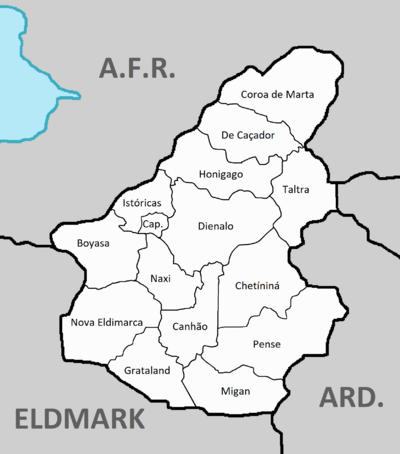 | ||||
| Kyrkavhopp | 1,087,414 | Armando Mesquita (ALV) | ||
| Aques | 1,522,429 | Bodauai Gonzales (FAL) | ||
| Rio Maior | 543,724 | Carlos Leste Lopes (FAL) | ||
| Saltes | 1,470,162 | Adolfo Zea Abreu (USS) | ||
| Branco | 1,123,300 | António Rovirosa (FAL) | ||
| Sandin | 517,626 | Tibá Velasco (FI) | ||
| Malmkvist | 258,813 | Agnes Ekbergsson (FAL) | ||
| Trindade | 652,469 | Santiago Nogueira (FAL) | ||
| Kunsla | 434,979 | Eriko Palmstruch (FAL) | ||
| De Castro | 761,214 | Alfredo Zeferino (FAL) | ||
| Hannaholm | 1,440,801 | Celesta Lundgren Ronaldo (FAL) | ||
| Uptaca | 217,489 | Jéssica Blomstedt (FAL) | ||
| Búfalo | 776,439 | Érica Barragán (FAL) | ||
| Blixtoken | 326,234 | Alexandre Syrén (FAL) | ||
| Arcanjo Miguel | 647,250 | Vítor Resende Araújo (FAL) |
Foreign relations
After their independence from the AFR in 1989, Vanhar had maintained a pragmatic approach to foreign policy, and at the time maintained a friendly relationship with the AFR when it was under Ramos and Erhardsson, the two cooperated with eachother to rebuild their respective economies. Vanhar also has had friendly relations with Eldmark, Ardesia, and Paretia. In 1992 they joined the effort to form the FNPI with Julío Pires of Paretia. In 1993 they attempted to join the NVO but would ultimately be rejected at home.
Ever since the rise of Tomas Pereira in the AFR and the FAL in Ardesia the relationship between the two became adversarial, especially under Lindahl, and Vanhar moved closer to countries like Chistovodia, Vinalia, and Choachua. It's current foreign minister, Mauricio Alcantara, has been in the position of foreign minister since 2008. Since 2017 Lindahl has attempted to calm down relations with the NVO and open up again, mostly with Alcantara's help. But rebels who wish to rejoin the AFR in the north have made it difficult for the two to approach eachother again.
Military
The military of Vanhar is the Vanharian Security Forces, formed out of the military of the AFR before the collapse, it is comprised of the Vanharian Army, Vanharian Air Force, and Vanharian National Guard. It does not have a naval force due to lack of coastline. The military has over 34,200 active personnel and over 50,000 in reserve. It's top suppliers are Chistovodia, Paretia, and Ardesia.
The Vanharian Army is the largest of the branches of the military, it is the ground force of the armed forces and has over 28,000 active personnel. The Vanharian Air Force is the air branch of the military, it has over 2,000 personnel but it is a very small air force, comprised of only 30 aircraft. The Vanharian National Guard is seen as an auxilliary force used in special operations and is the second largest branch and acts similar to the army.
Economy
Demographics
Ethnicities
Vanhar is a ethnically diverse nation, mostly thanks to the history of colonialism in the country. The largest racial group are white Vanharians, which includes ethnic Blostlandic, Paretians, and other Eucleans, they make up 41% of the country. Mixed pardos make up 38% of the population, mostly from miscegenation between ethnic Paretians and Blostlandic colonials and native Asterian women. 15% of the population is ethnically Bahian, mostly coming from the period of slavery that existed in Vanhar. 5% of the country is Native Asterian, this is mostly made up of the Johonai people, other natives include Dibe Ma, Pedrosan, Kotopa, Odavli and Zapoyans. Other ethnic groups include the Gowsa and Coians.
Religion
Religion in Vanhar

Due to it's history of colonialism and immigration, Vanhar is a fairly religiously diverse country. The majority of the country is Sotirian, the country has a large amount of Sotirian denominations that exist in it. Of the Sotirian groups, the largest is the Solarian Catholic Church, this is mostly due to the majority of the country having Paretian lineage, other groups include those of Gaullican and Etrurian heritage that live in Vanhar. The country is also largely Amendist, these mostly come from the Eldmarsk-Blostlandic population and immigration from northern Euclea. The largest Amendist church in the country is the Church of Blostland, which makes up about a third of the Amendists in Vanhar. Other Amendits include Gospelites and Embrians. The next major Sotirian group are the Brethren Church, they are mostly immigrants from Euclea who ended up in Vanhar.
Outside of Sotirianity, the country has a population of Native Asterian religious groups that were not converted by colonial leaders. The largest of these groups is the Johonai faith. Outside of these groups, other major religious groups include Irfan and Badi from Coius. The country is 10% irreligious, this population has gone up in recent years.
Languages
Due to it's history of colonialism Vanhar is also a linguistically diverse nation, with multiple languages being spoken in the country. The dominant language however is Luzelese, owing to colonialism from Paretia and the Asterian Federative Republic, other Paretian languages like Visegan, Tosuton, and Esmeiran are spoken by very small groups of people. The next major language in Vanhar is Blostlandic, coming from the country's colonial background of Blostland and Eldmark. The next major language in the country is the Johonai, which is the largest indigenous language spoken in the country. Other major native languages spoken include Dibe Ma, Pedrosan, Kotopa, Zapoyan and Odavli, and other languages spoken in Vanhar include Gaullican, Ziba, and Vespasian.
Blostlandic was originally the dominant language of Vanhar, but since the rise of Luzelese Blostlandic has become only commonly spoken in the southern regions. Since independence, Luzelese, Blostlandic, and Johonai have been ranked as official languages of Vanhar, but only recently has Johonai begun to be taught in schools and used in government offices.
Cities
Largest cities or towns in Vanhar
2020 census | |||||||||
|---|---|---|---|---|---|---|---|---|---|
| Rank | Department | Pop. | Rank | Department | Pop. | ||||
 Aques  Hannaholm |
1 | Aques | Capital de Aques | ?? | 11 | Cozmilho | Coroa de Marta | ?? |  Saltes  Branco |
| 2 | Hannaholm | Nova Eldimarca | ?? | 12 | Präri | Nova Eldimarca | ?? | ||
| 3 | Saltes | Coroa de Marta | ?? | 13 | Kunsla | Migan | ?? | ||
| 4 | Branco | De Caçador | ?? | 14 | Seiche | Naxi | ?? | ||
| 5 | Kyrkavhopp | Boyasa | ?? | 15 | Rio Maior | Canhão | ?? | ||
| 6 | De Castro | Naxi | ?? | 16 | Odago | Boyasa | ?? | ||
| 7 | Arcanjo Miguel | Taltras | ?? | 17 | Virvelia | Grataland | ?? | ||
| 8 | Trindade | Istóricas | ?? | 18 | Junqué | Coroa de Marta | ?? | ||
| 9 | Búfalo | Honigago | ?? | 19 | Halga | Dienalo | ?? | ||
| 10 | Blixtoken | Chetíniná | ?? | 20 | Matina | Dienalo | ?? | ||
Culture
Music
Vanharian music is a mixture of it's different cultural influences throughout it's history. This includes Paretian fado and flamenco, Blostlandic polska, and native music. Solarian music also became popular in the country. Common instruments used in Vanharian music include the Paretian guitar. Some well known composers from Vanhar include Luiz Caetano and João Bettencourt.
Vanharian music is considered it's own genre as it encorporates much of these musical genres, modern music genres are included in this as well, including solarian pop, and dansband. Some famous singers throughout earlier Vanharian history include Julian Nordin, Carlita Padin, and Raúl Romero. Later musicians include Alexandra, who became known as the "Queen of Vanharian music" and is likely the most well known musician from Vanhar, her music was extremely popular in the 1980s and 1990s until her murder in 1996.
Modern musicians in Vanhar include mostly pop singers, such as Miguel Liberato, Anabela Moura Dahlgren, and Luna Henriques. Rock has also become somewhat popular in Vanhar, with influence from Blostlandic metal, some rock bands in Vanhar include Ballo and Saqueador.
Cuisine

Vanhar has a very unique and diverse array of food that goes back to the history of the mixing of numerous cultures in the region. The cuisine of Vanhar is heavily based around mixing Blostlandic and Eldmarsk food, Paretian and Asterian, and Native Asterian food, this food that originates from Vanhar is known as Vanharian Fusion.
The first part of Vanharian food is Paretian quisine, which has influence from Paretia, which has a major focus on seafood, but Vanhar lacks a coastline making it based heavily around pork and beef-based foods. This includes alheira, cozido, an tigelada. The beef industry in Vanhar is still large and influences much of the cuisine of the country.
Next is Blostlando-Eldmarsk cuisine, which includes foods from Blostland heavily and mixed cultural foods from Eldmark, included wrapped fish and blostlandic meatballs.
Native Vanharian food such as Johonai cuisine is common and influencial as well, it includes things like corn-based meals, venison, sheep, and antelope.
Vanharian fusions mixes all of these foods together, the national dish, Almôndega, mixes all three together, it includes Paretian spices and sauce, Blostlandic meatballs, and Native spices and vegetables. It commonly uses beef, venison and tomato sauce with cheese.


















